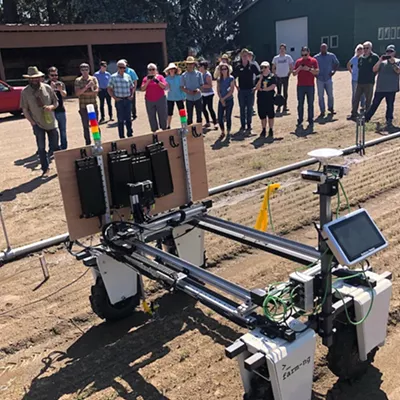Other problems with journalistic credibility abound. For example, in his introduction to "movers and shakers," Ted McGregor notes that "this is a club filled with white men," as if to offer a pseudo-apologetic aside about the article's exclusion of women and people of diversity. If McGregor and his writers were actually concerned about this absence, then they would have asked that oh-so-important journalistic question: Why?
Further, they might have questioned one of the assumptions of this issue that directly reflects on the absence of women and minorities from McGregor's pantheon: Is the vision of these white men the best vision for Spokane, or is it just a self-perpetuating extension of the same attitudes that have driven the city for the last century? Instead of these hard questions, instead of any hard questions, The Inlander offers personality sketches behind which most of these men can hide their only real motives: most "movers and shakers" are only interested in removing opposition and shaking loose profit from their various money trees without any regard for the compromise, dialogue and generosity that builds vibrant neighborhoods, enriched communities and, ultimately, healthful cities.
Of course, McGregor also doesn't note the fact that every article in the section was written by a white male and that the masthead of his own paper reveals a similar inequity, but that's a whole 'nother story....
A few examples of what's absent from the "Business Guide 2006": the increased numbers of eco-friendly businesses and environmentally-aware developers in the region; construction companies who emphasize recycling and sensitivity to a community's current and historical needs; Spokane employers who have instituted initiatives sensitive to diversity recruitment; and collaborative economic efforts aimed at making our city more unified and beautiful.
Instead of really exploring what businesses are and should be doing in Spokane, The Inlander has offered a tabloid of rah-rah support that reads more like a Chamber of Commerce publication supporting rampant development with no concern for long-range implications.
Tod Marshall & r & Spokane, Wash.
Way To Go, Inlander & r & Doesn't a pullout vanity section on local developers ("Developers To Watch," 2/23/06) impair The Inlander's ability to report on local development? It seems like a risk since nearly every major developer working in the region is profiled (and the "Developers To Watch," tagline is in no way instructive for the same reason). Despite the fact that the cover invited me to "Meet Marshall Chesrown," with something around 100 words from the subject buried in an article well over 3,000 words, I didn't feel that I'd met him and had the impression that the author hadn't either.
When I moved to Spokane, I was appalled that "that's the way to go," served as analysis among people in power. Roughly translated, it meant, "Without giving it any thought, I agree with my white, male, middle-aged friend in the tie." With its "hecks" "gut feelings" and "picking a winner," this article made me long for those bygone days of 2002.
Is Black Rock visionary? Cutting down trees and building houses is an American addiction that feeds on cheap land and, compared with values elsewhere, North Idaho is still a bargain. Is Kendall Yards visionary? National Town Builders, Nitze-Stagen and other developers were attached to the Summit site years ago with the same general plan.
Don't get me wrong, I like Kendall Yards; or at least, I think I do. I haven't seen any analysis of the project. But hey, I'm white, male and middle-aged. So, to quote the Kendall Yards companion article as it dismisses what are major traffic concerns for the city, "If that's all that stands in the way of putting so much property back on the productive tax rolls," then, that's the way to go.
Kevin Brownlee & r & Spokane, Wash.
A Decent Proposal & r & In "On the Street" (The Inlander, 2/2/06), Robert Delriccio questioned the recent downtown condominium projects undertaken by some of our city's prominent developers. Aside from his insensitive and snide remarks regarding the serious homeless problem Spokane faces, Delriccio raises an important point: Is downtown living only for the well-off, or will projects targeted toward Spokane's middle class also succeed? More important, though, his letter is based on a mindset that holds Spokane back.
This attitude will prohibit Spokane from ever reaching its potential. Why is there this belief that we must wait around for Ron Wells or Don Barbieri to make things happen? Both have done great things for this city, and will continue to do so. But if Spokane is to thrive, more people must step up to the plate. So, I extend an offer to Delriccio -- will you share in the cost of a market analysis for middle-income housing?
Tim Spellman & r & Spokane, Wash.
















